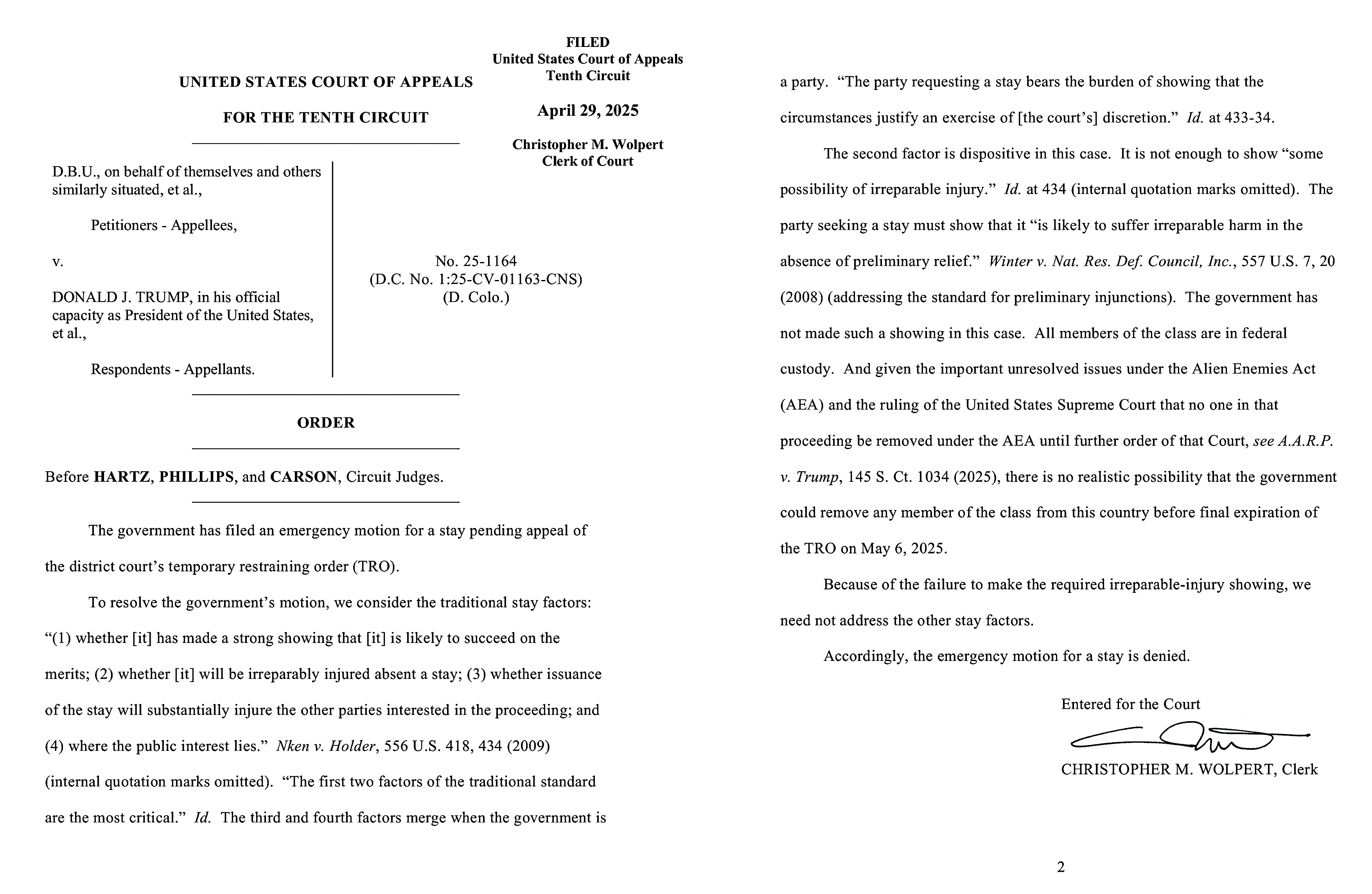Wie berichtet, hatte der District Court für den District (in dem Fall: = Bundesstaat) Colorado am Dienstag, den 22. April vorläufig entschieden:
„Respondents [= die US-Regierung] shall not move Petitioners and members of the provisionally certified class outside the District of Colorado. Respondents shall provide a twenty-one (21) day notice to Petitioners and members of the provisionally certified class detained pursuant to the Act and Proclamation. Such notice must state the government intends to remove individuals pursuant to the Act and Proclamation. It must also provide notice of a right to seek judicial review, and inform individuals they may consult an attorney regarding their detainment and the government’s intent to remove them. Such notice must be written in a language the individual understands.“
(https://storage.courtlistener.com/recap/gov.uscourts.cod.243061/gov.uscourts.cod.243061.35.0_2.pdf, S. 34)
Die Trump-Regierung beantragte danach, die District Court-Entscheidung für die Dauer eines beabsichtigten Rechtsmittel-Verfahrens außer Vollzug zu setzen. Nachdem sie mit diesem Antrag schon in der vergangenen Woche beim District Court selbst scheiterte, bekam sie jetzt auch von übergeordneten 10. Appeals Court einen Korb:
„the emergency motion for a stay is denied.“
Die Argumente für und gegen den stay-Antrag hatte ich am Montag ausführlich dargestellt; auf die Frage der Erfolgsaussichten in der Hauptsache geht der Appeals Court gar nicht erst ein. Damit geht er auch nicht auf den Punkt ein, den ich am Montag am ausführlichsten behandelt hatte – nämlich die Frage, ob der District Court vielleicht voreilig entschieden hat (die Regierung hatte argumentiert: Die Antragsteller „are not facing removal under the Proclamation or the AEA“ – und zwar deshalb, weil die Regierung sie [noch] nicht entsprechend benachrichtigt hat).
Der Appeals Court läßt den stay-Antrag der Regierung schon daran scheitern, daß sie nicht gezeigt habe, sie ohne die Außer-Vollzug-Setzung der District Court-Entscheidung wahrscheinlich einen irreparablen Schaden erleiden werde:
„It is not enough to show ’some possibility of irreparable injury.‘ Id. [Nken v. Holder, 556 U.S. 418] at 434 (internal quotation marks omitted). The party seeking a stay must show that it ‚is likely to suffer irreparable harm in the absence of preliminary relief.‘ Winter v. Nat. Res. Def. Council, Inc., 557 [gemeint ist: 555] U.S. 7, 20 (2008) (addressing the standard for preliminary injunctions). The government has not made such a showing in this case. All members of the class are in federal custody. And given the important unresolved issues under the Alien Enemies Act (AEA) and the ruling of the United States Supreme Court that no one in that proceeding be removed under the AEA until further order of that Court, see A.A.R.P. v. Trump, 145 S. Ct. 1034 (2025), there is no realistic possibility that the government could remove any member of the class from this country before final expiration of the TRO on May 6, 2025.“
(Hv. hinzugefügt; A.A.R.P. v. Trump, 145 S. Ct. 1034 (2025) = https://www.supremecourt.gov/search.aspx?filename=/docket/docketfiles/html/public/24a1007.html [Apr 19 2025])
Die Entscheidung des District Court, die die Regierung außer Vollzug setzen lassen wollte, ist ohnehin bis zum 6. Mai befristet; bis dahin wird der District Court über die nächste Stufe des vorläufigen Rechtsschutzes (Prelinary Injunction) entscheiden.
Die vom Appeals Court angeführte Supreme Court-Entscheidung gilt de jure ausschließlich für Nord-Texas („in that proceeding“ – weil dort das Ausgangsverfahren stattfand), hat aber – de facto – auch für alle anderen AEA-Fälle Gewicht.
Es wurde kein abweichendes Votum veröffentlicht; ein Abstimmungsergebnis wurde auch nicht mitgeteilt; zuständig waren: Richter Hartz (2001 von George W. Bush nominiert), Richter Phillips (2013 von Obama nominiert) und Richter Joel M. Carson (2013 von Trump nominiert).

https://storage.courtlistener.com/recap/gov.uscourts.ca10.90040/gov.uscourts.ca10.90040.31.0_2.pdf (2 Seiten)



